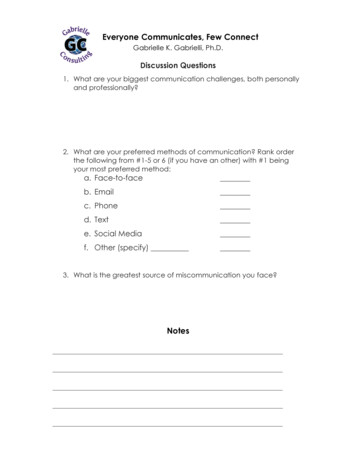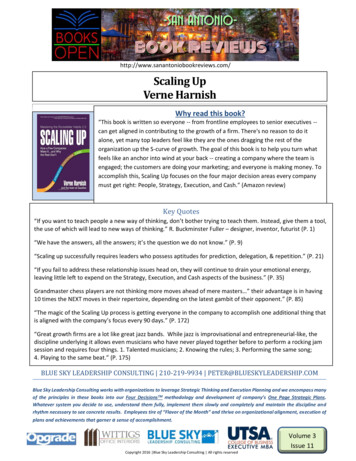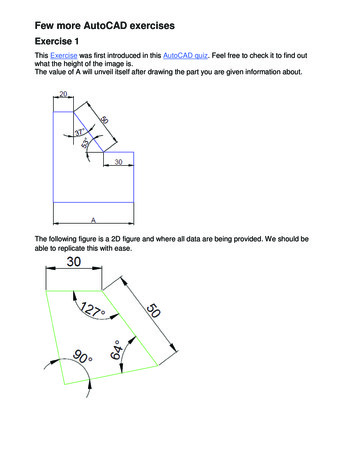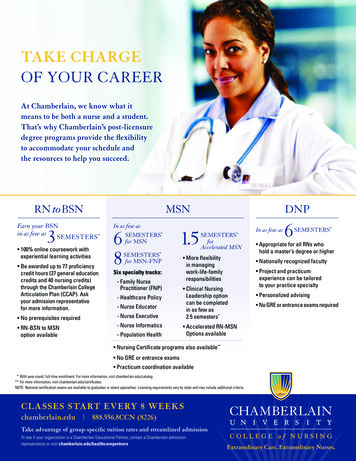
Transcription
Everyone Communicates, Few ConnectGabrielle K. Gabrielli, Ph.D.Discussion Questions1. What are your biggest communication challenges, both personallyand professionally?2. What are your preferred methods of communication? Rank orderthe following from #1-5 or 6 (if you have an other) with #1 beingyour most preferred method:a. Face-to-faceb. Emailc. Phoned. Texte. Social Mediaf. Other (specify)3. What is the greatest source of miscommunication you face?Notes
Everyone Communicates, Few ConnectCOMMUNICATION SELF-ASSESSMENTAlways Usually Sometimes Rarely NeverI listen carefully and rephraseinformation for better understanding.I put myself in the speaker’s place inorder to better understand themessage.I ask questions if the message is notclear.I recognize when certain words,phrases, or ideas prejudice meagainst the speaker, so I redirectmyself to listen objectively to what isbeing said.I concentrate on what is being saidand avoid distractions.I control my emotions when receivinginformation from others includinginformation that I may not want tohear.I communicate with people in theirworld including via social media.I am intentional with communicationabout focusing more on askingquestions of the other person thansharing information about me.I make eye contact whencommunicating with others in person.I use appropriate body language andnonverbal cues when listening.All of the items on the self-assessment represent good communication skills onthe part of the listener. Your goal is to use all of these skills “usually” or “always”.Work toward improving those areas in which you show a need for improvement.Communication FactsWe speak at an average rate of 125 words per minute.We listen at about 150-400 words per minute.We think at about 1000-3000 words per minute.For questions, email gabrielle@gabrielleconsulting.com.2
Everyone Communicates, Few ConnectConnecting Principles1.2.3.4.5.Connecting increases your influence in every situation.Connecting is all about others.Connecting goes beyond words.Connecting always requires energy.Connecting is more skill than natural talent.Connecting Practices1. Connectors connect on common ground.2. Connectors do the difficult work of keeping it simple.3. Connectors create an experience everyone enjoys.4. Connectors inspire people.5. Connectors live what they communicate.Maxwell, John C. (2010). Everyone Communicates, Few Connect: What the Most EffectivePeople Do Differently. Thomas Nelson Publishers. 262 pages.Central Truths1. If you want to succeed, you must learn how to connect with others.2. High achievers care about people, view subordinates optimistically, seekadvice from everyone regardless of position, and listen well to others.3. Maturity is the ability to see and act on behalf of others.4. We remember 85-90% of what we see and less than 15% of what we hear.5. Connecting always requires energy; we must intentionally and willinglyconnect with others. This requires initiative (go first); clarity (be prepared);patience (slow down); selflessness (give); and stamina (recharge).6. If you are responsible for leading people or communicating with others, it isespecially vital for you to find ways to recharge.7. A bad beginning makes a bad ending (Euripides).8. People connect with stories, not statistics.9. It is the job of a leader to bring clarity to a subject, not complexity.10. Three words are essential to connect with others: brevity, levity, repetition.11. Leadership is about inspiring people to do things they never thought theycould (Steve Jobs).12. The mediocre teacher tells, the good teacher explains, and the greatteacher demonstrates.13. Vision without passion is a picture without possibilities.14. People ask three questions about their leaders: Do they care for me? Canthey help me? Can I trust them?15. Preparation yields confidence and passion yields conviction.For questions, email gabrielle@gabrielleconsulting.com.3
Everyone Communicates, Few ConnectApplication of Concepts1. When communicating, find common ground, make communication simple,capture people’s interest, inspire others, and be real.2. When you communicate, you must include: thought (something I know);emotion (something I feel); and action (something I do).3. When communicating, attempt to connect on four levels: visually,intellectually, emotionally, and verbally. Connect visually; eliminate personal distractions (do not allow anythingto distract from your message); expand your range of expressions; movewith sense of purpose, pay attention to surroundings, remove obstacles,and reduce distance from audience. Connect intellectually; you must know your subject and yourself. Connect emotionally; the words used are far less important than theenergy, intensity, and conviction with which you use them. Connect verbally; what we say and how we say things make quite animpact.4. Bring intentional energy to conversations. Gear up mentally andemotionally for communication opportunities.5. Think of ways that you can increase your energy when speaking to anaudience.6. Read voraciously and then file quotes and illustrations. Have supportingmaterial ready to include in any important message.7. Become a student of communication; study effective speakers.8. The larger the audience, the more energy you will need to bring to yourcommunication.9. Build upon agreement, not disagreement. Don’t make assumptions aboutpeople; take into consideration other people’s views, avoid indifference,and don’t isolate yourself.10. Availability requires intentionality; spend time with others.11. Keep talks to three ideas. Get to the point.12. Deliver results before delivering the message; communicate fromexperience. You must live what you communicate.13. Do not commit one or more of the four unpardonable sins of acommunicator: being unprepared, uncommitted, uninteresting, anduncomfortable.14. If you want to get your message across, you have to learn how tocommunicate in someone else’s world.“Good leaders must communicate vision clearly, creatively, and continually.However, the vision doesn't come alive until the leader models it.”- John C. MaxwellFor questions, email gabrielle@gabrielleconsulting.com.4
Everyone Communicates, Few ConnectConnecting with OthersConnectors connect on common ground. When you find things in commonwith others, you instantly establish a connection. You never know when thatconnection will lead to a long-lasting personal or professional relationship. We allhave choices available to finding common ground. Maxwell says common groundchoices are:1. - I will choose to spend time with others.2. - I will listen my way to common ground.3. - I will be interested enough in others to ask questions.4. - I will think of others and look for ways to help them.5. - I will let people into my life.6. - I will care about people.7. - I will think of myself less so I can think of others more.8. - I will move from my world to theirs.For questions, email gabrielle@gabrielleconsulting.com.5
Everyone Communicates, Few ConnectInspiring and ConnectingConnectors inspire people. People don’t follow unenthusiastic leaders. True leadersinspire others. The “inspiration equation” is the following:What people know includes that you understand them and you are focused on them.What people see includes your conviction and your example. What people feel includesyour confidence in yourself and in them as well as your gratitude for them. When youinspire others, you help them achieve things they may have never thought possible.Connectors live what they communicate, which creates trust and credibility. Thosefeelings convey integrity for the person communicating. Maxwell says we should askourselves the following questions as part of our “credibility checklist”:1.2.3.4.5.6.7.8.Have I connected with myself?Have I made right my wrongs?Am I accountable?Do I lead like I live?Do I tell the truth?Am I vulnerable?Am I following the Golden Rule?Do I deliver results?Action ItemsAction Item I Will Commit To DoingBy What Date?“True transformation to leadership begins when people overcomefears and self-limiting beliefs to get out of their comfort zone andinto their strength zone.” - Dr. Gabrielle K. GabrielliConnect with me and with all the materials and other resources after today’ssession on your website portal: http://gabrielleconsulting.com/lscu2016For questions, email gabrielle@gabrielleconsulting.com.6
Everyone Communicates, Few Connect: What the Most Effective People Do Differently. Thomas Nelson Publishers. 262 pages. Central Truths 1. If you want to succeed, you must learn how to connect with others. 2. High achievers care about people, view subordinates optimistically, seek advice from everyone regardless of position, and listen well to .











